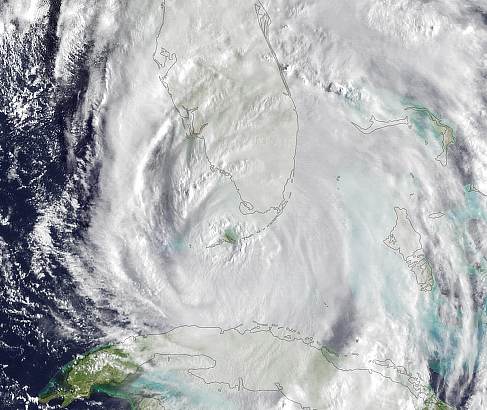A new study looking at the effects of climate change on hurricanes and tropical cyclones suggests that the insurance, reinsurance and insurance-linked securities (ILS) industry may need to prepare for storms that cause even wider swathes of damage and losses, with a warmer world linked to damage extending further inland.
 It’s not a new hypothesis, as the reinsurance and ILS market has been discussing the fact storms may be degrading more slowly since as far back as 2008, after hurricane Ike caused damage far inland into Texas.
It’s not a new hypothesis, as the reinsurance and ILS market has been discussing the fact storms may be degrading more slowly since as far back as 2008, after hurricane Ike caused damage far inland into Texas.
While the reinsurance and ILS industry will also acutely remember the fact certain catastrophe risks models for hurricanes were adjusted for a slower degradation of tropical wind speeds overland, causing significant shifts in expected losses for covered portfolios of risk.
Those cat model changes were eventually toned down and rolled back to a degree, but now this new study suggests the premise was correct, that climate change and a warmer world will cause hurricanes to be more destructive further inland.
The study, published in Nature yesterday, explains that typically hurricanes cause their most destructive wind damage around the landfall area, because they are fuelled by moisture from the sea and hurricane intensity decays rapidly once they move over land and that fuel is removed from the equation.
But, after analysing intensity data for North Atlantic land-falling hurricanes across the last 50 years, the researchers conclude that the data shows that hurricane decay has slowed.
In addition, they conclude that the slowdown in the decay of hurricanes over land over time, is “in direct proportion to a contemporaneous rise in the sea surface temperature.”
The researches say that this has made a stark difference to the ability of hurricanes to cause damage further inland.
A hurricane from the late 1960s lost about 75 per cent of its intensity in the first day past landfall, the researchers said, but now the corresponding decay has fallen to only about 50 per cent.
Hurricane Isaias this year provided what may be an example of this, with strong tropical storm winds seen as far north as New York state, with damage seen over a huge swathe of the U.S.
As well as the historical data analysis and interpretation, the researchers performed computational simulations which suggest that warmer sea surface temperatures induce a slower decay in hurricanes over land, by increasing the availability of moisture that a storm carries with it as it hits land.
“This stored moisture constitutes a source of heat that is not considered in theoretical models of decay,” the researchers explained, suggesting that any models not considering this may not be accurately forecasting hurricane damage potential over land.
On top of this, the researchers said that, “We show that climate-modulated changes in hurricane tracks contribute to the increasingly slow decay.”
Concluding, “Our findings suggest that as the world continues to warm, the destructive power of hurricanes will extend progressively farther inland.”
All of which has clear ramifications for insurance, reinsurance, ILS and catastrophe bond interests, as well as for the catastrophe risk modelling community.
The study suggests that for U.S. hurricanes, the time it takes to decay a storm’s intensity once it has moved onshore has almost doubled in around 50 years.
It’s a stark finding, especially as research suggests climate change and warming seas and weather is accelerating and has moved much faster in the last decade than it was 50 years ago, which suggests this timescale of decay may be lengthening all the time.
The researchers place the blame on climate change and that as a result areas further inland will feel damaging effects of hurricanes more frequently over time.
It’s important that catastrophe risk models used to measure risk and expected losses to ILS instruments such as catastrophe bonds, as well as to reinsurance portfolios, consider this kind of research and are factoring in the potentially impactful and damaging influence of our changing climate on peak storm and weather perils.
Update: A number of meteorologists have claimed that this study doesn’t provide sufficient evidence for its claims of hurricanes being more destructive inland due to climate change.
As ever, it’s down to the industry to take its own view on this and studies of this kind provide valuable inputs and talking points, but their findings aren’t always as clear-cut as they may seem.
 View all of our Artemis Live video interviews and subscribe to our podcast.
View all of our Artemis Live video interviews and subscribe to our podcast.
All of our Artemis Live insurance-linked securities (ILS), catastrophe bonds and reinsurance video content and video interviews can be accessed online.
Our Artemis Live podcast can be subscribed to using the typical podcast services providers, including Apple, Google, Spotify and more.































